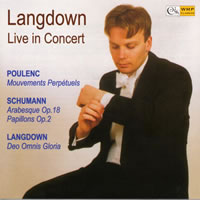| Landgdown Live in Concert |
Poulenc, Schumann and the performers own composition Deo Omnis Gloria brought to you by WMP Piano Classics
Buy this album now CD: £12.00 + p&p |
| Track Listing | |||
| Mouvements Perpétuels | Francis
Poulenc (1899-1963) |
||
| 01 | i. Assez modéré | 1.25 | |
| 02 | ii. Très modéré | 1.29 | |
| 03 | iii. Alerte | 4.12 | |
| 04 | Arabesque Op. 18 | Robert Schumann (1810-1856) | 7.29 |
| 05 | Papillons Op.2 | Robert Schumann (1810-1856) | 15.29 |
| Deo Omnia Gloria (2001) | Christopher Langdown (b. 1971) | ||
| 06 | i. Hymn | 3.58 | |
| 07 | ii. Lake Gennesaret | 2.41 | |
| 08 | iii. Resurrection | 4.19 | |
Sleeve Notes
Francis Poulenc (1899-1963)
Mouvements Perpétuels were written in 1918 - Poulenc’s first vintage year. In each of these uniquely magical and enchanting child-like pieces the composer uses ostinato. No. 1 adheres etdcfy to its ostinato, opening with a memorable melody which droops pentatonically before being dissonantly mutated and playfully tickled with acciaccaturas. After the momentum subsides in five-bar coda, the movement dissolves into pianissimo bitonality. No. 2 has much poise and grace and the young composer toys with the rising fourth and major second. As in all three Mouvements, Poulenc avoids drawing to a dose by means of conventional harmony - this time, a pianissimo glissando humorously slinks out 'off-key’. No. 3 is the longest and most impulsive of the pieces. It also has the richest harmonies and widest dynamic range - in fact, the performer is instructed very specifically with regard to tonal variety. As the masic fades out on an unresolved dominant thirteenth, one is left with the impression that the music could go on forever.
Robert Schumann (1810-1856)
The Arabesque is one of a series of smaller-scale pieces Schumann created after his first big spate of piano music. Exquisite yet direct, this short work was composed in 1839. The first section, which is recalled in full between contrasting episodes, sways sweetly to and fro. The solemn and urgent reply in the minor conveys a deepening sense of regret. However, the optimistic opening theme refuses to go away even after a further more animated minor passage. The beautiful coda, which is broad and contemplative, gives us one final passsionate statement before fading to its close. The piece is dedicated to the wife of Major Anton Serre, who encouraged Schumann in his engagement to Clara.
Papillons (Butterflies) Op.2 is one of the composer’s earliest works and is comprised of 12 pieces in total. Just before the work was published, Schumann wrote to his mother in May 1832: “Now the papillons flutter on the wide, glorious world of spring. Spring itself stands outside the door and gazes at me - a child with heavenly blue eyes - and now I begin to comprehend my own existence.”
Christopher Langdown (b.1971)
Deo Omnis Gloria (All Glory to God) wss premiered in Spain in 2001 and comprises three neo-romantic pieces conceived in a typical late 19th century styte. The first piece, Hymn, is inspired by the Holy Mass. The music essentially aims to portray the nobility of liturgical ceremony whilst combining two particular emotions evoked by the Mass - reverence and joy. After borrowing the Alleluia for its introductory meditation, the main theme is presented; hushed at first before growing into a more passionate statement. The piece also hints at the sonorous sounds of organ, choir and church bells. Lake of Gennesaret is based on St Luke’s account of the miracle catch of fish on Lake Gennesaret. The Lake is represented throughout by swirls of rippling arpeggios and, as the boat slows, we hear the nets cast out into the deep. There follows a meditative bridge passage expressing Jesus falling deep into prayer, whilst the volatile finale encapsulates the disciples’ amazement and elation as they struggle to haul in a gigantic catch which mirrors the depth of Christ’s Love. Finally, as the boats are filled to nearly sinking point, they head for the shore across the glistening lake. The final piece is a depiction of the Resurrection. After a solemn octave deep in the lower register, the opening features a soaring chordal ascent which symbolises the rising of the soul. This leads into a shimmering, highly animated central section which represents supernatural dimension and liberation from the confines of the human body. Although we are drawn away in the closing bars, the triumphant finale aspires to convey the awesome splendour and glory of Heaven and the Beatific Vision.
2002 Christopher Langdown
Credits
Recorded Live in Concert, University of Glasgow, 7 February 2002 Photography by Glen Shelley
All rights reserved. Unauthorised copying, hiring, lending, public performance and broadcasting prohibited
| Instruments: | Piano |
| Genre: | Classical |
| Format: | CD |
| Our Ref: | A0021 |
| MCPS: | WMP 637247 |
| Label: | WMP |
| Year: | 2002 |
| Origin: | UK |
| Please click here for Artist Information and Contact Details | |


